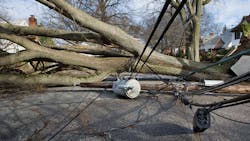The year 2020 is in the books and, unfortunately, electric utilities through no fault of their own, are worse for the wear. A derecho tore up the Midwest; wildfires struck the usual Western states; tropical storm Isaias walloped the Northeast; Hurricanes Laura and Sally devastated parts of the South; and disasters caused mayhem in additional pockets around the country. Power companies are in business to provide safe, reliable, and affordable electric service to their customers 24/7. Can we do more to improve the reliability and resiliency of our operations?
A growing number of electrics are turning to risk-based business continuity plans to improve preparedness. Risk-based planning is not for the faint of heart. Your eyes will roll into the back of your head quicker than you can say chi-squared if you focus on abstract issues. It’s easy to run down rabbit holes worrying about what is an inherent risk and what is a residual risk. However, the overarching goal of risk-based planning, which is to prioritize where to focus limited resources to achieve the greatest level of resilience or recoverability, is more critical today than ever before.
Freebase describes business continuity as a broadly defined set of planning and preparatory activities intended to ensure that an entity’s critical business functions will either continue to operate during serious events that might otherwise have interrupted them, or will quickly regain operational status. Business continuity strategies generally address:
1. Resilience-design or operation to ensure critical business functions are not significantly affected by disruptions.
2. Recovery-preparations for restoring functions that are damaged in an event.
3. Contingency-measures to regain critical functions if primary plans are not successful.
Putting risk analysis and business continuity planning together yields the modern version of emergency planning on steroids. For those folks who avoid statistics, take heart, because most of the heavy lifting for risk assessments today can be performed by powerful computer modeling. In fact, advanced analytics can be employed to predict how weather events, natural disasters, and myriad other types of events impact outage risks. With such knowledge, organizations can optimize capital and operational expenditures to maximize reliability and resiliency. Further, better insights for recovery and emergency response planning are possible.
There are many sources for guidance regarding business continuity planning. Two examples cited by Randy Heisler with Life Cycle Engineering during a recent presentation are NFPA 1600 and ISO 22301. These standards cover plan creation, implementation and maintenance for continuity, emergency, and crisis management. Documentation, training materials, exhibits, SOPs, forms, and audit checklists are available for both the NFPA and ISO standards.
Comprehensive business continuity plans (BCP) should address all risks faced by an organization. After this year, we realize we must plan for pandemics and abnormal environmental threats such as smoke-contaminated air. Also, cyber and physical infrastructure threat protection are increasingly critical to minimizing disruption to structures, operational technology, data, business functions such as call centers and essential work force communications. The list of business continuity threats appears to be growing, but near the top for many utilities for a long time have been weather and vegetation.
Together, weather and vegetation are leading contributors to utility outages. One company has combined near-real-time data, machine learning and artificial intelligence to help utilities optimize vegetation maintenance programs and utilize outage prediction solutions to better prepare for weather-related outages. IBM offers cloud-based services which gather the extensive quantities of granular satellite imagery and weather data needed to perform these tasks; something few utilities have the resources and expertise to do on their own.
Bob Berglund with IBM’s The Weather Company explained during a recent T&D World webinar how data from satellite imagery and other sources can be used to perform spectral analyses for an entire utility service territory to provide near real-time vegetation outage risk assessments. Combined with weather forecasts and utility asset as well as historical outage information, The Weather Company can provide extremely specific outage risk predictions from seven days to 0 hours before a weather event. The company’s modeling capabilities even extend to predicting where flooding may be a problem. Collectively, IBM’s tools can aid with all three aspects of business continuity planning: resilience, recovery, and contingency.
Many prognosticators believe we will see increased frequency and severity of storms, wind, and drought. We know there are other risks on the rise as well. Thankfully, there are an increasing number of resources, including valuable planning tools, increasingly assessable data, machine learning and AI to help us prepare. As Randy Heisler recently told an audience, even when small risks align, bad things can happen. Unfortunately, we cannot eliminate all disruptive events, but we can prepare for them and mitigate their impact on our businesses with solid risk-based continuity plans.
About the Author
David Shadle
Grid Optimization Editor
Dave joined the T&D World team as the editor of the Grid Optimization Center of Excellence website in January 2016.
Dave is a power industry veteran with a history of leading environmental and development organizations, championing crucial projects, managing major acquisitions and implementing change. Dave is currently a principal at Power Advance, LLC, an independent consulting firm specializing in power project development, research and analysis, due diligence and valuation support. Dave is also a contributing consultant for Transmission & Distribution World. Prior to Power Advance, Dave held business and power project development positions with The Louis Berger Group, Iberdrola Renewables, FPL Energy and General Public Utilities. He is a graduate of Pennsylvania State University, the New Jersey Institute of Technology and Purdue University.
